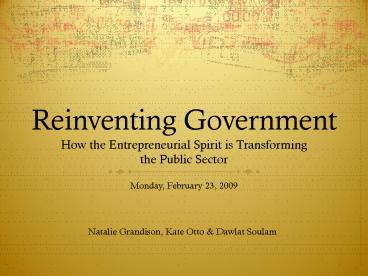Reinventing Government - PowerPoint PPT Presentation
1 / 19
Title:
Reinventing Government
Description:
A snapshot of governments in 1992 shows evidence of an emerging governance paradigm. Bureaucracies are bankrupt, ... Example: Fillet mignon versus chicken ... – PowerPoint PPT presentation
Number of Views:3827
Avg rating:3.0/5.0
Title: Reinventing Government
1
Reinventing Government
- How the Entrepreneurial Spirit is Transforming
the Public Sector
Monday, February 23, 2009
Natalie Grandison, Kate Otto Dawlat Soulam
2
Introduction
- A snapshot of governments in 1992 shows evidence
of an emerging governance paradigm - Bureaucracies are bankrupt, markets have
collapsed, but a hybrid is developing American
Perestroika - Provide an outline of a new way to conducts the
publics business
3
The FactsThe Ten Commandments
- CATALYTIC
- CUSTOMER-DRIVEN
- COMMUNITY- OWNED
- ENTERPRISING
- COMPETITIVE
- ANTICIPATORY
- MISSION-DRIVEN
- DECENTRALIZED
- RESULTS-ORIENTED
- MARKET-ORIENTED
4
I Catalytic Government Steering Rather Than
Rowing
It is not governments obligation to provide
services, but to see that theyre provided1
- Public, private and non-profit collaboration
- Public promotes social equity
- Private provides products
- Non-profits provide human services
1 Osborne, David and Gaebler, Ted. Reinventing
Government How the Entrepreneurial Spirit is
Transforming the Public Sector. 30
5
II Community-Owned Government Empowering Rather
than Serving
- Case Study Lee Brown, Houston Police
- Client vs. citizen
- Governments can transfer control to community and
organizations - Remove barriers
- Provide seed money, training, and technical
assistance - Move resources necessary to deal with problems
6
III Competitive Government Injecting
Competition into Service Delivery
- Three Types of Competition
- 1. Public vs. Private
- 2. Private vs. Private
- 3. Public vs. Public
- Competition is only as good as it is regulated
- Competition breeds accountability,2 but also
unregulated markets breed inequity3
2 Osborne, 94 3 Osborne,104
7
IV Mission-Driven Government Transforming
Rule-Driven Organizations
Historically, most public institutions have
been designed to serve mass marketsToday we need
institutions whose mission is to serve one
niche4
- Case Study Louisville Housing Services
- Build a culture around mission
- Tools Sunset laws, reviews, and zero based
budget
4 Osborne, 131
8
V Results-Oriented Government Funding Outcomes,
Not Inputs
- Fund success and prevent failure
- Three approaches
- 1. Link pay to performance
- 2. Use performance information as a management
tool - 3. Tie spending to results
9
VI Customer-Driven Government Meeting the Needs
of the Customer, Not the Bureaucracy
- Case Study GI Bill vs. Veterans Hospital
- Customer choice creates most the efficiency
- Total Quality Management
10
VII Enterprising Government Earning Rather
Than Spending
- Example Fillet mignon versus chicken
- Governments should make a habit of gauging the
return on their spending as if it were an
investment5 - Four Way to Make Profits
- 1. Turn the profit motivate to public use
- 2. Charge user fees
- 3. Invest on expected returns
- 4. Turn managers into entrepreneurs
5 Osborne, 205
11
VIII Anticipatory Government Prevention Rather
Than Cure
- Case Study Health Care
- Two Characteristics of Anticipatory Government
- 1. Focus on prevention not cure
- 2. Builds foresight into decision making
12
IX Decentralized Government From Hierarchy to
Participation and Teamwork
- Example 9/11
- Consolidating agencies and super agencies
- Shared information
- Participatory management
- New challenges of the information age
- Knowledge is either relevant to a task or
irrelevant not higher or lower6
6 Osborne, 268
13
X Market-Oriented Government Leveraging Change
through the Market
The question we ask today is not whether our
government is too big or too small, but whether
it works. President Barack Obama
- Most powerful method of steering is structuring
the marketplace - Giving incentives instead of commands
- Government programs vs. markets
14
Analysis
- Winners Losers
- Crisis Response
- Conflicting Principles
15
Winners Losers
- Example Prison
- Solutions were presented under the assumption
that they are all win-win
16
Crisis Response
- Author assumptions
- During times of intense crisis the Depression
and two world wars the bureaucratic model works
superbly. - In a crisis goals are clear, widely shared, tasks
are straight forward, everyone is willing to
pitch in for the cause - Conflicts with the reality of a globalized world
17
Conflicting Principles
- JFK and the mentally ill population
- Community ownership vs. decentralization
- Anticipatory government vs. catalytic government
18
Conclusion
- Governments seeking to improve efficiency and
quality should follow these commandments - Creation of a visionary government
- the ultimate test in government is not
performance but re-election
19
Thank you































![[PDF] Reinventing the Sheikhdom: Clan, Power and Patronage in Mohammed bin Zayed's UAE [PDF] PowerPoint PPT Presentation](https://s3.amazonaws.com/images.powershow.com/10119875.th0.jpg?_=20240904079)